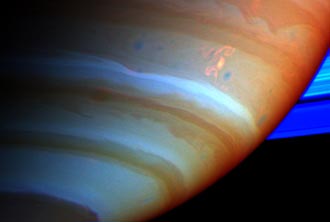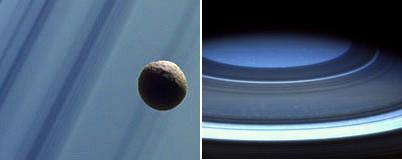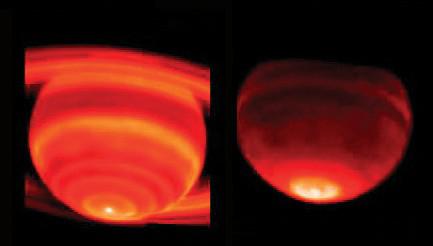Among the new findings are wandering moons and moons that are a collection of pebbles, new rings full of clumps, splitting storms and a dynamic magnetosphere

NASA's Cassini spacecraft continues to make fascinating scientific discoveries. Among the new findings are wandering moons and moons that are a collection of pebbles, new rings full of clumps, splitting storms and a dynamic magnetosphere.
"For the past seven months it has been a non-stop science mission. We had an end of data, and we already have many scientific results." said Dr. Dennis Mattson, Cassini Project Scientist and NASA's Jet Propulsion Laboratory in Pasadena, California.
Pictured: Saturn's atmosphere and rings are seen here in unnatural colors, compiled from images taken by Cassini in near-infrared light using filters used to sense different amounts of methane gas. Image credit: NASA/JPL/Space Science Institute.
Weak density waves are caused in Saturn's rings by the small moons Atlas and Pan. These waves were used to refine the calculation of the masses of these moons. The mass data suggest that these moons are as porous as a pile of gravel. They resemble the shepherd moons of Saturn's F ring, Prometheus and Pandora.
Another discovery is of a tiny moon, with a diameter of about 5 kilometers and which was named Polydeuces. Polydecus is a Trivian companion or moon of Dion. Trojan moons are near the gravitationally stable points before or after a larger moon. Saturn is the only planet known to have moons accompanied by Trojan moons.
The new findings, published in this week's issue of the journal Science, include refining the calculations of the orbits of some of Saturn's smaller moons.
One intriguing result is Pan's inclined, highly elliptical orbit in Saturn's A ring. The shape of the orbit is unique, and this indicates the type of interaction the moon has with the ring material that surrounds it. If Pan's orbit remains extreme due to these interactions, then planets that grow in disks of material surrounding stars around which solar systems form also have eccentric orbits.
Several pale rings were discovered in Cassini images. Some of them lie in some of the gaps in the rings and this may indicate the existence of tiny moons that serve as shepherds for these rings. Some of these rings are twisted, a possible hint of nearby moons.
The scientists also found variations in the winds on Saturn depending on the latitude, and small storms emerging from larger storms. For the first time, Cassini captured possible evidence of the processes that cause the winds to continue on Saturn. The observations offer a glimpse into the processes that transport the energy through heat conduction from Saturn's interior to keep the winds strong.
Other results improve our knowledge of Saturn's complex magnetic environment. "Saturn's magnetosphere is unique. Its dynamics are similar to that of Jupiter, but chemically it resembles water-based plasmas that surround comets," said Dr. David Young. Yang is Cassini's principal investigator for the Plasma Spectrometer instrument at the Southwest Research Institute in San Antonio.
Another surprising discovery was made by the ion and neutral mass spectrometer, which measures the oxygen ions above the plane of the rings. "This is surprising, firstly because the rings are made of water ice," says Dr. Hunter Waite, the principal investigator of the spectrometer and works at the University of Michigan in Ann Harbor. "This could have important implications for identifying the spectral configurations that will be used to search for life on planets outside the solar system."
The abundance of molecular oxygen on Earth is exclusively related to biology, but these new measurements from Saturn suggest the possibility that lifeless processes are associated with glacial surfaces that may create an independent pathway for creating molecular oxygen in the atmosphere.
Blues Saturn in new Cassini images
13.2.2005

New color images transmitted by the Cassini spacecraft show that the Northern Hemisphere is in a slightly bluesy mood. In the first image, the icy moon Mimas stands above a stunning landscape of Saturn's northern hemisphere shining in the blue sky and a shot of the rings. In the second picture you can see the north pole region of Saturn in a dull blue color.
The blue color of Saturn's northern latitudes originates from the cloud-free region in the upper atmosphere. An accurate understanding of the phenomenon will come only after further study of these images by scientists.
In the first color image, Mimas is seen moving in its orbit against the blue background of Saturn's atmosphere, separated by the shadow cast by the rings. Several large craters are visible on the face of Mimas and give the icy moon a dimpled appearance.
The second image shows the polar region of Saturn, where the shadow caused by the rings surrounding the pole appear as dark bands. The shadow of the rings in the high latitudes refers to the position of the plane of the rings farthest from the planet. In other words, the northernmost shadow in the image is caused by the outer edge of the A ring. Patches of bright clouds are also visible throughout the region.
The view of Saturn and Mimas was captured by Cassini's narrow-angle camera on January 18, 2005 at a distance of about 1.4 million kilometers from Saturn. The image of the polar region was captured using the wide-angle camera on December 14 at a distance of 719,200 kilometers from Saturn.
Measure the heat for Saturn
7.2.2005

These two photographs, side by side in artificial colors show the heat emission from Saturn. The data were collected on February 4 using the Keck Observatory on Mauna Kea, Hawaii. Both images were taken in different ranges of infrared frequencies. The left image was taken at a wavelength of 17.65 microns and is sensitive to the temperatures of Saturn's upper atmosphere. The image on the right was taken in the 8 micron wavelength range and is sensitive to the temperatures in Saturn's stratosphere.
The prominent hot spot at the bottom of both images is Saturn's south pole. The warming of the southern hemisphere was expected, as Saturn crosses the solstice in the southern summer, but the sudden changes in temperature depending on the latitudes was not expected.
The temperature in the troposphere increases as you approach the pole suddenly near 70 degrees south latitude from 88 to 89 degrees Kelvin and then to 91 degrees Kelvin right near the pole. Near the 70th latitude, the temperature in the stratosphere rises even more sharply from 146 degrees Kelvin to 150 and then to 151 right at the pole.
While the rings are too faint to be detected at a wavelength of 8 microns (right) they are clearly visible at 17.65 microns. The ring particles surround Saturn to the left at the bottom of the image and to the right at the top of the image. The lower left ring is colder than the upper right, because its particles simply move out of Saturn's shadow where they cooled. As they orbit Saturn they heat up to their maximum just before they pass behind Saturn in the shadow.
For the video on the NASA website
